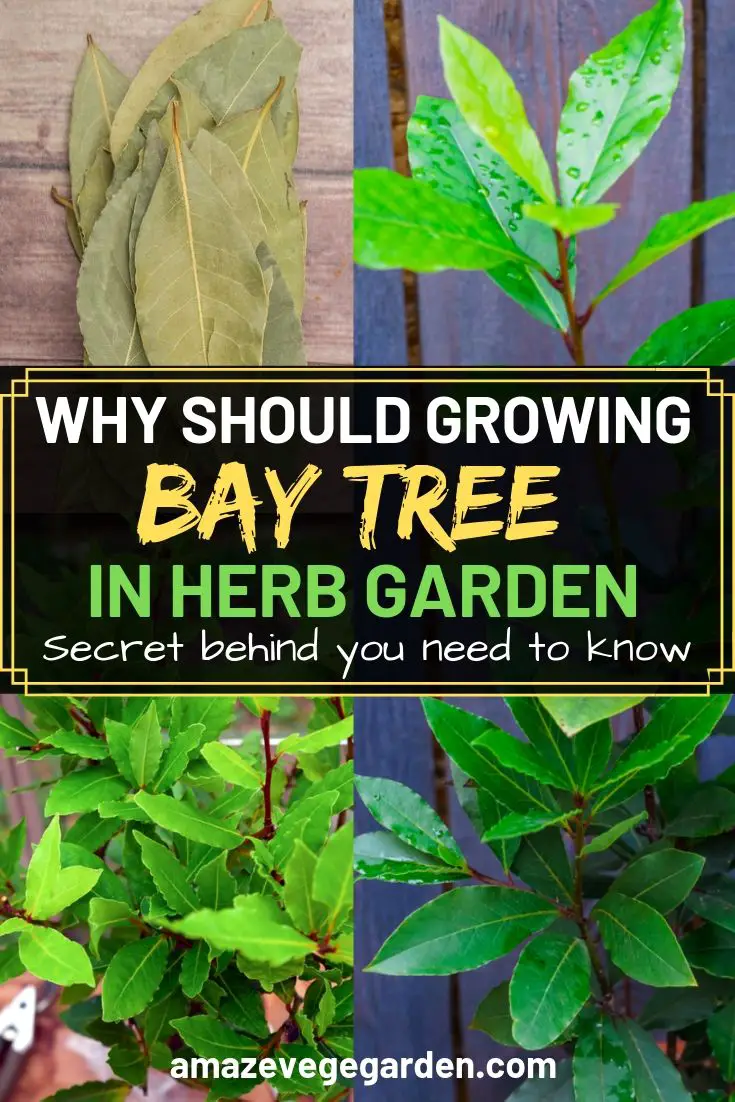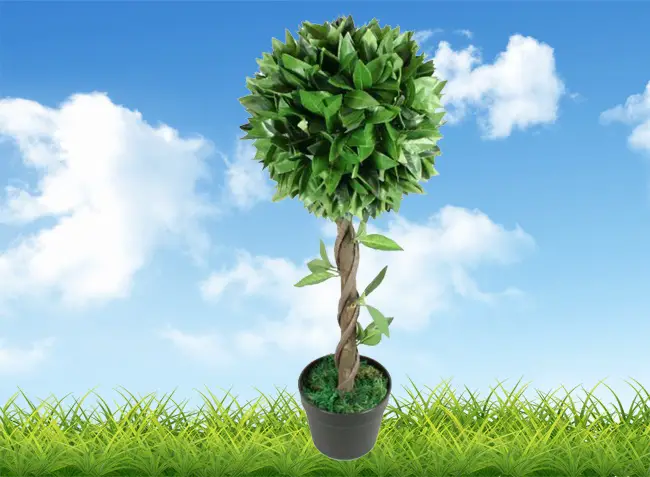The bay leaves you can buy off the shelf in a supermarket grow on the evergreen Bay Laurel Tree. They have a distinct aroma and are widely used to grow bay trees in your garden, cook, and prepare perfumes. The leaves have a sharp, bitter flavor with a taste somewhat similar to cinnamon bark.
No herb garden is really complete without a bay bush or tree in it, but if you start growing bay alongside other herbs in your herb garden, bear in mind that bay trees can get huge very quickly and dwarf the other herbs in your herb garden.
Over a couple of years, a small bay bush can grow into a dense, lush shrub or tree (see the photograph on the left – this bay tree started as a small shrub a couple of years ago).
So when you start growing bay make sure you have planned the layout of your herb garden so that your bay tree doesn’t deprive your other herbs of light and water. I’ve provided more tips on the growing bay below.
One of the big benefits of the growing bay, apart from the culinary benefit, is that because it’s an evergreen, the bay tree or bush can add color to your herb garden during the winter when other herbs and plants have died or gone into hibernation for the winter.
Lots of herb gardeners shape their bay trees so that they become year-round features in the garden. You’ll probably come across many gardens that have shaped bay trees in them, even though there might not be another herb on the site.
Your evergreen bay will provide you with a plentiful supply of leaves throughout the year, although lots of cooks claim that partly or completely dried bay leaves have much more flavor than fresh bay leaves.
The flavor and fragrance of the bay are very distinctive. If you cook a lot using herbs, you’ll find that many recipes (mostly Mediterranean- style) recommend using bay leaves in stews and soups.
Why Did Roman Generals Wear Bay Leaf Wreaths?
To the Greeks, the bay tree was sacred. Its symbolism was extended by the Romans, who were real enthusiasts for the growing bay.
The Romans routinely used bay leaf wreaths to symbolize wisdom and glory. Roman generals returning to Rome after successful military campaigns overseas were crowned with wreaths of sweet bay leaves, and bay leaves became a recognizable feature carved into the tops of columns in Roman temples and buildings.
Perhaps this is a good point at which to mention that sweet bay is often described as a laurel, but its the only member of the laurel family that’s edible – all the other members of the laurel family are poisonous.
Choose the Right Size Bay Tree for Your Herb Garden
As mentioned above, every good garden center or garden outlet will have sweet bay shrubs or trees for sale. You’ll probably find you have a choice of a basic sweet bay shrub or a sweet bay tree and perhaps a choice of different cut shapes.
As we mentioned earlier in this article on growing bay, the tree you choose should be suitable in size for your herb garden. When choosing it to bear in mind that you’ll need to leave an area of a couple of feet diameter free around the base of your sweet bay tree.
If you plant other herbs near the tree, they’re unlikely to flourish as the tree grows. Because of this limitation, I don’t plant bay trees directly in my herb garden; I plant them in a container in another part of my garden.
Whatever you choose to do when you start growing bay, make sure you choose a position for your sweet bay tree that gets the full sun and makes sure the soil around the root of your bay tree is rich (use good compost and dig it into the soil) and well-drained.
How You Can Use the Leaves from Your Bay Tree
Like many other herbs, bay leaves are not only useful in cooking. They also have protective and medicinal properties. These uses for bay are described below.
Cooking with Sweet Bay Tree Leaves
Bay leaves have been used for flavoring food for hundreds of years. In both European and American cuisines. French cooks use them extensively in their food as a bouquet garni.
The bouquet garni is a bundle of herbs wrapped in a muslin cloth tied up with string. The bouquet garni keeps the herbs together during the cooking.
It’s often used with casseroles, stocks, sauces, soups, etc. because you can remove the whole bag of herbs afterward before the meal is served. The traditional bouquet garni always contains bay leaves, parsley (or parsley stalks, which have lots of flavors), and a few thyme sprigs.
If you use whole bay leaves in your cooking, make sure you remove them before serving because they can be very abrasive to the digestive tract.
Alternatively, you can crush the bay leaves before cooking, but if you do this, removing the fragments of the bay leaf after cooking will be difficult. Because of this, it is not difficult to understand why the bouquet garni is used.
Many cooks grind up their sweet bay tree leaves before using them because the ground up bay imparts a much stronger taste to the food.
Bay Leaf Insect Repellent
Bay leaves used to be scattered in pantries (kitchen cupboards) to repel meal moths, flies, roaches, mice, and silverfish. Good traditional use was to place a few bay leaves in the flour bin to repel weevils. However, it’s much less likely to find flour bins these days than it used to be.
Using Bay Leaves as Medicine
Substantial new research has also been done on using bay leaves as antiseptics and anti-inflammatory drugs. Sweet bay These leaves are also thought to contain many anti-cancer properties. When used at high concentrations, the chemical compound lauroside B isolated from Laurus nobilis is an inhibitor of human melanoma (skin cancer) cell proliferation.
Here’s a more detailed list of bay medicinal recipes.
Drying & Storing Your Bay Leaves
As we mentioned above, when you want a stronger flavor of the bay in your cooking, you should use previously dried bay leaves, and for an even stronger flavor, crush these leaves up well before you use them.
To dry bay leaves, lay them out on a large tray in a warm area. Turn them over periodically until they’re dehydrated, and then store them in a suitable airtight jar.
The dried leaves will be olive green and will keep for a long while, but they gradually oxidize and become brown when this happens to throw them away and dry a fresh batch. The brown leaves will have lost their flavor and potency.
Read also: How to Grow Herbs in Pots.
Did you find this post useful? Would you like to get back to it later? Save THIS PIN below to your gardening, herb garden, or house plant board on Pinterest! Thanks 🙂



“The greatest deer velvet extract has been sourced by your research and
imported it.